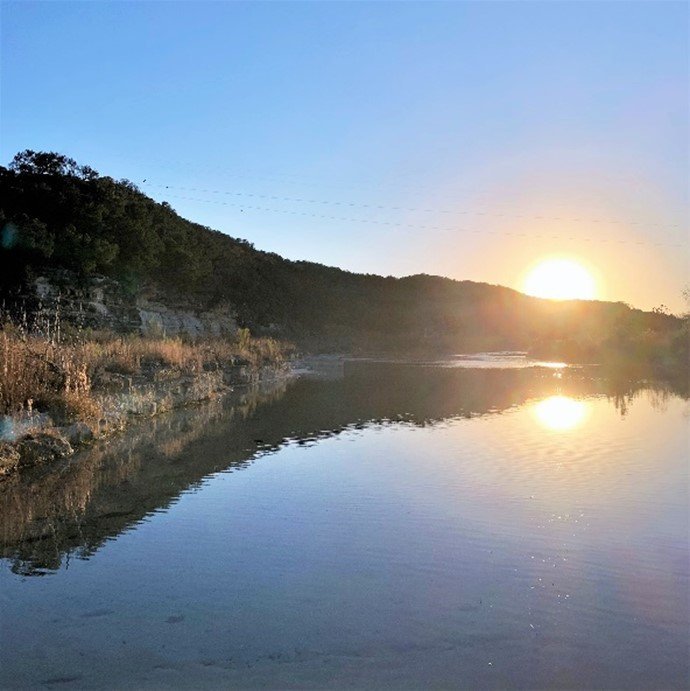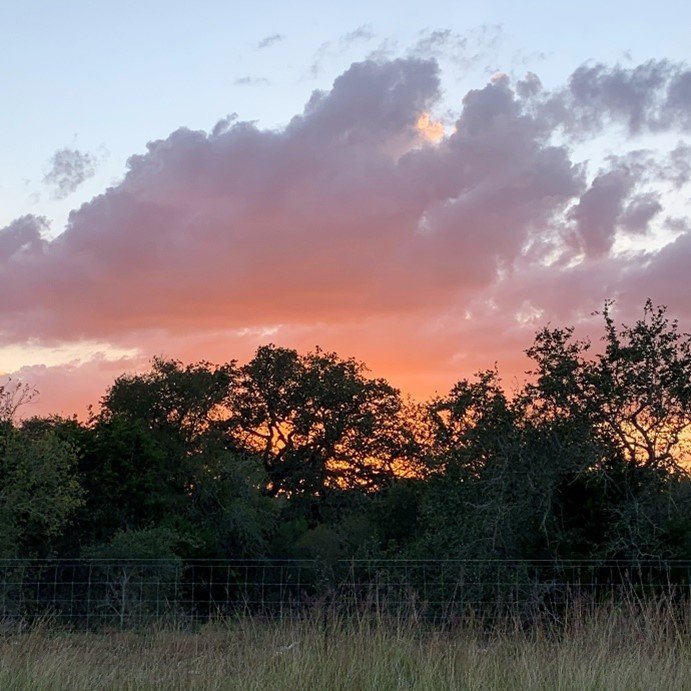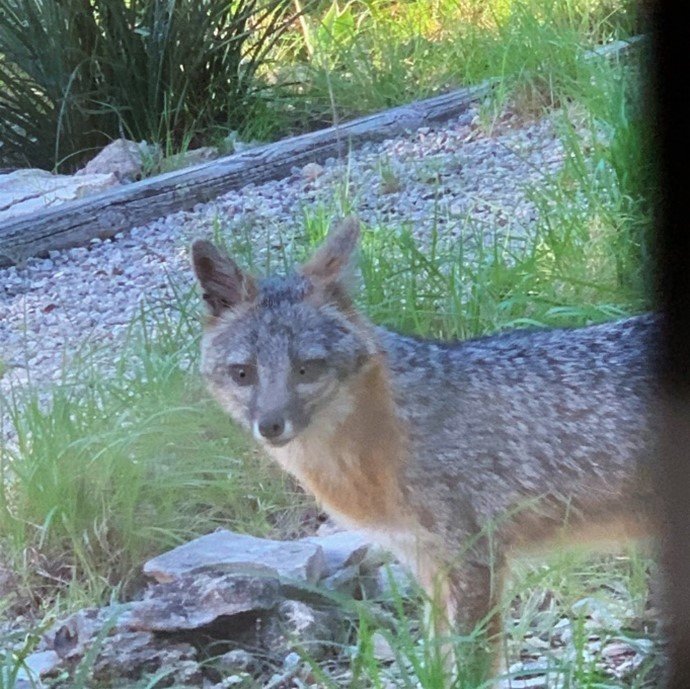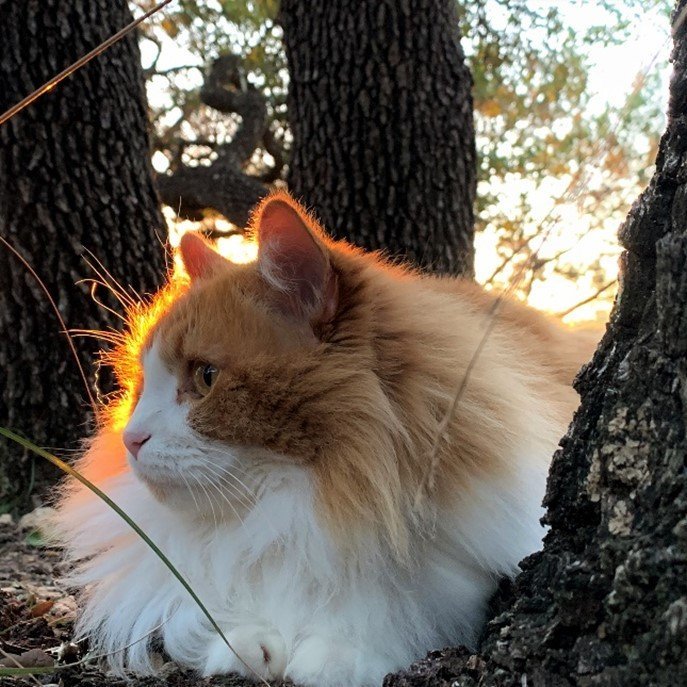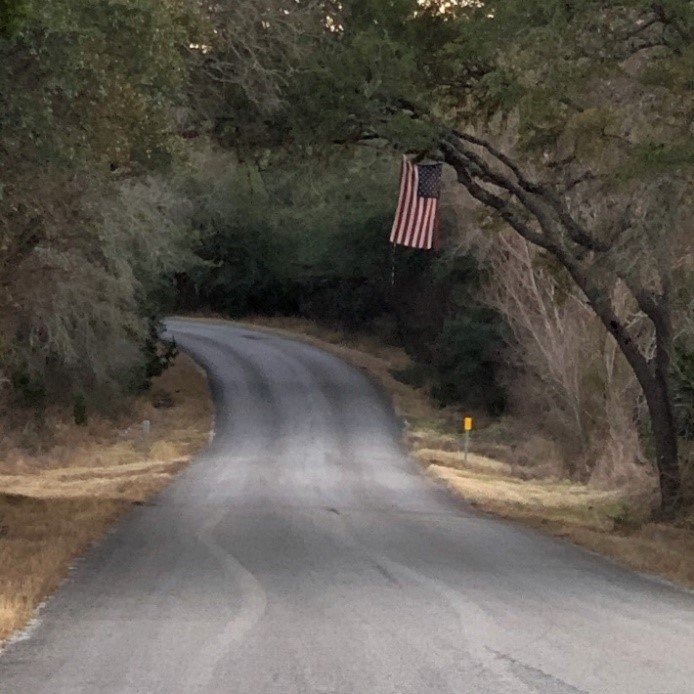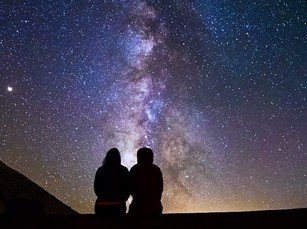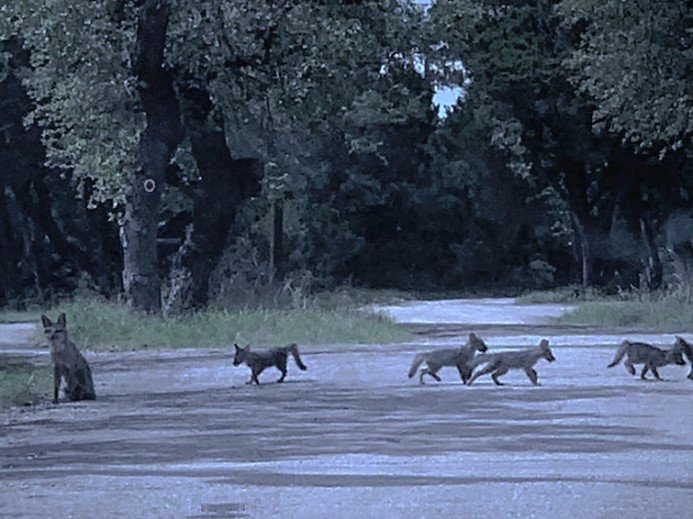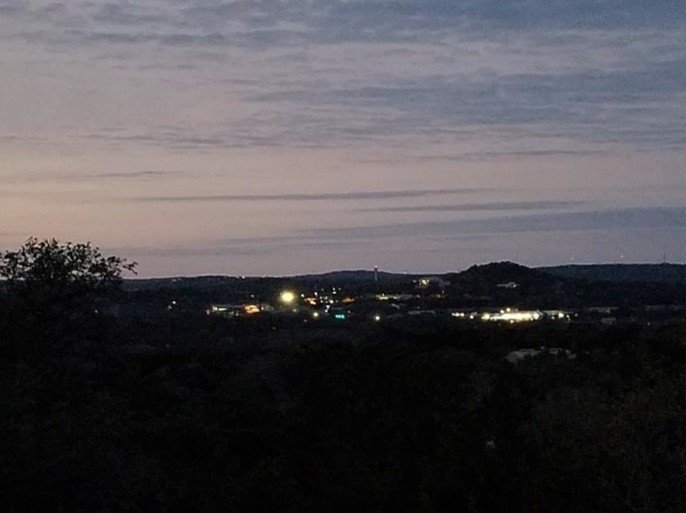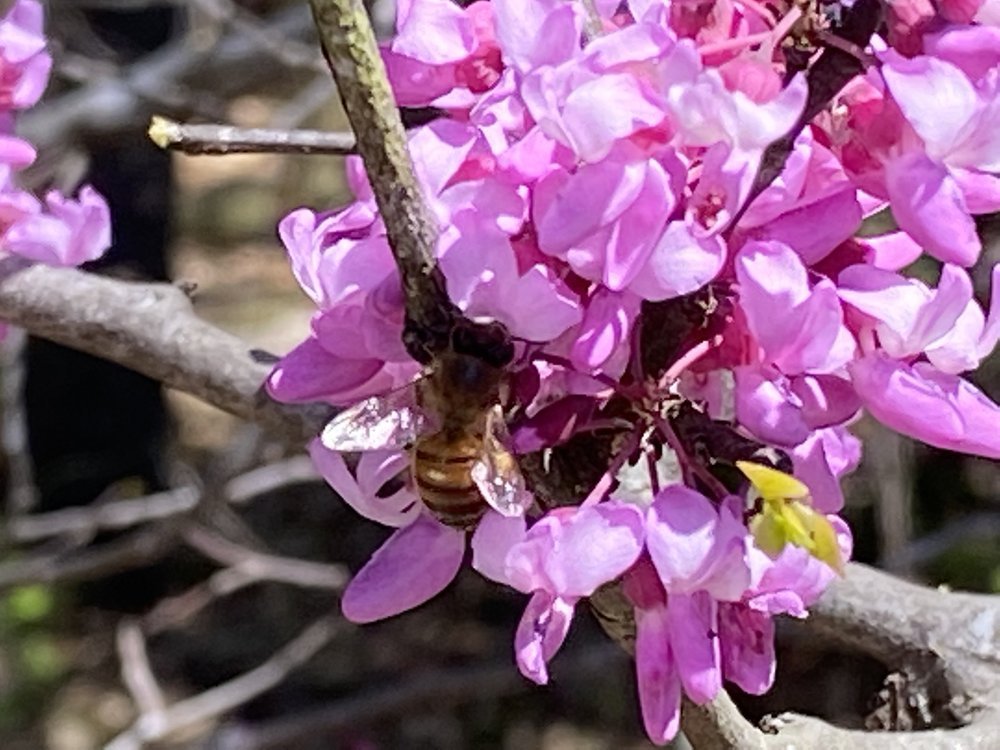The Hays Humm - April 2022
THE HAYS HUMM
Hays County Master Naturalist Magazine
April 2022
Tom Jones - Betsy Cross - Mimi Cavender - Constance Quigley - Steve Wilder
Photos taken with iPhone
This favored place, the central hills of Texas—why is it that we grow up here or move here and think it beautiful? For many of us, the real Hill Country starts at sunset—the quiet, the velvet dark among oaks and cedars, the star-strewn night. Our grandparents respected natural darkness as a time of rest for all of nature. But our grandchildren may never experience a dark night. It will be their loss. And our doing.
So here it comes. First the beauty. Then the problem. And the solution!
THE BEAUTY
Got a few minutes for beauty? Grab a jacket. We’ll explore the Hays County night—from dusk to dawn. The photographs are, of course, dark, but our eyes adjust to the darkness—and see wonders.
Dusk is daylight that lingers, passing from white into night. It can be featureless or a firestorm.
Dusk can fade from pearl to pewter, or riot orange, pink, purple and gold.
Depending on an evening’s cloud structure and air quality, the sun sets fast and white in bright blue air. Or warms us in its afterglow.
A sunset will mimic an approaching wildfire. Or just casually drop a red ball off the edge of the earth.
Clouds and trees, our houses and we can bathe in “magic hour” pink or in burnished brass and copper.
A winter sunset dazzles us before the dark.
Like a bedtime story, dusk quiets the day’s things. Then night hides them to sleep, hunt—or survive.
Can you mentally list all the nocturnal creatures you know in your area? Who hunts whom out there in the dark? And who, would you guess, is the most efficient hunter?
Yep. The deadliest nocturnal predator in your neighborhood is not the Red-Shouldered Hawk or the shy Grey Fox who always spooks Hays County newcomers. It’s your cat. While Buddy is indoors clawing your couch, his outdoor life is his guilty secret. His ancient DNA is fierce, so it’s impossible to take the lion out of the pussycat.
Best keep cats inside and “fixed,” just in case. But in any case, spaying/neutering has nothing to do with this one. It’s darkness that triggers the prey drive.
Night is a necessary beauty. A night’s darkness, gently lit by moon and stars as all nights were before electric light, kerosene, or campfires, is what all nature (including humanity!) needs for refreshment, renewal, healing, and growth. We desperately need darkness before the dawn.
Dawn streams out of the east to Hays County hilltops earlier than to our ranchland and river valleys.
Morning sun brightens the pastures and flares through the trees. Back roads go golden.
Here at home, half up the west side of a hill, I hear a hundred cardinals greet the day. But I never get to see the sun on the horizon and have to wait half an hour to see dawn fingering through my cedars.
And so go the seasons, to fry us or freeze us as the earth tilts. We and all of nature go about our day’s business, only to weary and wait again for rest. For night. The beauty. The healing dark.
THE PROBLEM
HILL COUNTRY NIGHT — LOVE IT OR LOSE IT
Lovely, this Hill Country night, right? You’ve got to admit, it’s what many of us have felt is an essential part of the Texas Hill Country heritage. It’s the dream of our pioneer forebears’ Texas—to strive through sun scorched noons and cedar smoked evenings, finally to rest and renew themselves and their animals in the comforting dark of night. They knew the moon’s phases, the changing angle of sunsets and sunrises, the constellations’ shifting with the seasons. Here in the Hills, the night sky was as orienting to the old Texans as the Polestar was to sailors.
For us Boomers, starry nights are the stuff of storybooks and a mid-century childhood catching lightning bugs out in the grass: magic! For our children—maybe not so much. When my Manhattan-born four-year-old son visited my parents in San Antonio in the 1970s, a nighttime walk around our suburban block had him panicked, begging to go back indoors. He’d never seen a black sky full of stars; he said he felt he was falling up into them! Thirty years later, our city stars had been lightwashed right out of the sky.
When I moved from San Antonio in 2014 to a semi-rural neighborhood in Wimberley, I was thrilled to see stars again—even the edge of our galaxy arching overhead! But now, only eight years later in 2022, with suburban development grinding into Hays from three directions, the Milky Way is visible in most parts of Hays County on only the clearest nights. The authentic Hill Country is losing its stars.
From high above the earth, it’s clear why.
From the International Space Station — NASA
Let’s see Central Texas as the ISS crew see it: (Remember, distances on the ground appear shorter as you move toward the top of this telephoto.) Interstate 35 curves northeastward along the Balcones uplift from San Antonio (lower left) to Austin (upper right), with giant blinding Houston in the lower right corner of the shot. New Braunfels is the strongest light smear next on the highway after San Antonio, then San Marcos with Canyon Lake and Wimberley triangulating just to the north. Kyle is that bright string before Buda and the southern suburbs of Austin’s light explosion. And that clutter of small white lights below San Antonio and across the Coastal Plain?—Hundreds of fracking rigs, all lit bright white! Deep Hill Country is still relatively dark. Ask again in five years.
We flee the cities to rural areas, seeking refuge from traffic and noise and a soul-killing rising cost of living. Hays County towns Buda, Kyle, and San Marcos have been the fastest growing areas in the United States for the past four years. Their new suburbs scrape flat, pave over, and light up the woods and pasture between them, even as Austin has been rolling toward Driftwood and Dripping Springs. We’re loving the Hills. We’re loving them to death.
Loss of Texas’ natural world— its woods and grasslands, soils, and wildlife—to poorly regulated urban sprawl is a part of what Texas Master Naturalists concern themselves about. Our water—its quantity and quality—is another. Two important volunteer-based programs of Hays County Master Naturalist reach out to all Hays County residents—municipalities, businesses, schools, homeowners, and landowners—providing expert knowledge about the Hays natural environment and tools for us all to enjoy it, protect it, and use it wisely. Know more about our outreach programs Wild About Nature (WAN) and Habitat Enhancing Land Management (HELM).
A third environmental flag for Central Texans to rally around is the dark sky movement. In the same way that much of human activity pollutes the land and water, our light pollutes the sky, brightens away the necessary dark of night.
So just what makes it a problem, anyway, if we lose the night? To answer that, the go-to source for all things light pollution and its mitigation is the International Dark-Sky Association (IDA). Their website is a revelation.
Locally, we can explore Hays County Friends of the Night Sky under the leadership of Hays County Master Naturalist Cindy Luongo Cassidy, their events calendar, and the extraordinary resources they offer for our participation from our boardroom, school, and home.
Summarized from the Dark Sky movement, here is what we know: If we light up the night, we lose beauty, heritage, health, science, safety, and security. Quickly, let’s take them one by one:
In our photos here, we’ve remembered some of the beauty. Take a walk after sunset and see for yourself. Do you see stars? Or floodlights. We’ve remembered too that the night’s dark is our historic heritage in these Texas hills we love. We’ve touched on our “need for night” for our health: for rest, growth, and healing of animal muscle and brain.
So now consider the science of night. Scientists track seasonal bird and butterfly migrations. They know that many species migrate at night, and that bright light from the ground can disorient them. Light pollution can also disrupt their feeding, sleep, and mating patterns to the point of species decline.
Because of an increasingly light-obscured night sky, amateur and professional astronomers have few places left on earth dark enough to use ground-based telescopes; observation is moving from hilltops out into earth orbit—and to the far side of the moon, where we assume the sky is still dark.
We already know the sleep science, right? Our circadian (24-hour) biorhythms of waking and sleeping depend on a healthy balance of daylight and dark night. To get a good night’s sleep, we set our screens and phones on blue light filter before bedtime, we don’t read screens in bed, and we sleep in a completely dark bedroom. Not only sleep loss, but light itself at night is now directly linked to weight gain, depression, and Alzheimer’s disease!
Ending daylight savings time and returning us and all of nature to standard time’s natural light-dark biorhythms might simplify life. But our use of artificial light would still have to follow the basic rule: the least possible, the right kind, the right way.
In sum: We and the rest of nature need balanced natural light: plenty of outdoor light during the day, minimal warm lighting indoors in the evening, and eight hours of total darkness until dawn. It’s essential for a developing child and for all adults into a long healthy old age. It’s what our mother always nagged us to do. She was right all along.
OK, but what’s this about too much light and our safety. Check this out: those super-bright white head lamps your dealer convinced you you needed for night driving safety on your new vehicle are actually a driving hazard! The blue end of the spectrum that produces bright white light causes far more severe highway glare than traditional lamps. In this extraordinary photograph, compare the cars on a dry Route 12 between San Marcos and Wimberley: the white headlights flare and obliterate the road, its markings, and details of the oncoming traffic.
As white-lamped vehicles pass us, we are for a few moments driving completely blind. Anything on the shoulder or crossing the road is invisible in the glare.
In the same way, folks spend good money on bright up-lighted or wall-wash lighting for their home or business—usually just excessive lighting—and unshielded white floodlights for parking lots and the city center. And our beloved Friday Night Lights—guys, please turn ‘em off as soon as the final whistle blows, and turn on your warm-spectrum down-lighted work lights!
Wimberley and Dripping Springs are certified Dark Skies compliant cities. Congratulations! But in that downtown Wimberley photo I took last week from my neighbor’s hilltop, who are y’all out there who might do better? And from my porch: what are those mysterious bright lights along the Blanco southwest of downtown?
In bringing our urban habits out into the Hills with us, we often exaggerate security lighting and waste our money doing so. My neighbor across the road has a garage-mounted bright white LED “security” floodlight so strong that it not only makes noon of his driveway, but it washes across the road, up my driveway and into my kitchen, where I can cook by it! Leaving my driveway, I can’t see the edges or end of the pavement. What he doesn’t know is that, contrary to popular belief, bright security lights create pools of light, blinding us to anything outside the pool. Bright floods and spots are actually counterproductive; our eyes see potential threats better when our surroundings are lit mostly by the night’s ambient light: warm skyglow, moonlight, even starlight. Have you noticed how you can see out onto your property better when your porchlights are off? Our Hays cities and neighborhoods have ordinances prohibiting any light that crosses property lines—making it legally as much an invasion of neighbors’ privacy as are noise, livestock, pets, hunters, and thieves. If security lighting is a must for you, it should be warm light and shielded (hooded) to project it straight downward, away from neighbors and the earth’s atmosphere. Here are some specifics from Friends of the Night Sky.
So, those are the problems associated with careless use of modern lighting, eroding our world’s beauty, heritage, health, science, safety, and security. If not abated, all this blinding light amassed in the public and private places of our world washes up into the atmosphere, making the night a permanent dusk.
THE SOLUTION—Easy!
With lighting, the hack is to use less, the right kind, in the right way.
To save the night sky, less lighting means minimal lighting: only what’s absolutely necessary for the task. We select the right kind of lighting: warm instead of white. Warm light is easier on our eyes, our sleep, and our health. And we use our minimal, warm lighting in the right way: we use designs that shield it from escaping into the atmosphere; we point it down, and when it’s not needed, we turn it off!
Our grandchildren’s world will be what they learn from us. They’ll inherit this beautiful part of Texas with—or without—healthy nature and starry nights. They’ll know—or never know—how valuable the night can be.
Join so many proud Texans in saving the dark Hill Country nights we love.
Photo: Mihail Minkov
It’s easy—you might start here:
From McDonald Observatory, March 2022:
Did you know that 1 out of every 3 birds migrating through the U.S. this spring passes through Texas? Most migratory birds fly at night, and many use the stars or moon to navigate. Bright lights of commercial and residential buildings attract and disorient birds, causing them to navigate off course, collide with structures, or be vulnerable to predators.
Turning off unneeded lights, or shielding them so they are visible from above, can save countless birds this spring.
Learn more at https://texanbynature.org/projects/lights-out-texas/
Lights Out Texas is a campaign of education, awareness, and action. It asks Texans to turn off our outdoor lights at night during the spring and fall bird migrations to help protect the billions of migratory birds that fly over Texas annually. It is a collaborative effort by many good people.
Texan by Nature and Audubon Texas lead Lights Out Texas efforts across the state in collaboration with all of these organizations: Texas A&M University (Biodiversity Research and Teaching Collections) and Texas Parks and Wildlife Department (Texas Nature Trackers) provide centralized leadership for volunteer research efforts.
Cornell Lab of Ornithology provides technical guidance and mapping/alerts through BirdCast, employing real-time analysis of bird migration traffic as detected by radar. So cool! Sign up…
International Dark-Sky Association, Texas Master Naturalist™, Hays County Master Naturalist, and Hays County Friends of the Night Sky urge all Texans to make ours a safe state for migrating birds. Here’s what to know:
Spring Migration Dates:
Full Spring Migration Period:
March 1 – June 15.
Critical Spring Peak Migration:
April 22 – May 12
Proclamation Recognizing Lights Out in Hays County…
…Therefore be it resolved that the Hays County Commissioners Court proclaims, One: March 1 through June 15, 2022, and August 15 through November 2022, shall hereafter be known as “Lights Out Hays County Months” in the county of Hays County, Texas. Two: Hays County shall work with the collaborative team organized by Hays County Friends of the Night Sky to provide information to the public about the Lights Out Hays County campaign, the impacts of lights on bird migration, and the benefits of reducing light pollution and energy consumption. Adopted this, the 29th day of March, 2022.
County Judge Ruben Becerra commented, “I think [the Lights Out Hays County Project] is absolutely essential…and of course, as a major—although it’s politically correct to say fiscal steward—I’m a cheapskate! If you don’t need a light, just don’t have it on. I just think that’s a really good thing.”
Commissioner Walt Smith, Precinct 4, added that Hays County continues “…to work with the state legislature in trying to give actual zoning authority to [Hays] County to address [light pollution] issues…I look forward in the coming year to work with [Friends of the Night Sky and partners] on this.”
Hays County Friends of the Night Sky leader Cindy Luongo Cassidy reiterated that seeking this Proclamation for Hays County was a collaborative effort and asked if the Lights Out Project could consider the County a partner and advocate. Judge Becerra assured her, “This Proclamation would lend itself to our support.”
Lights Out Hays County partner Advocates as of April 1, 2022, include Hays County Texas, Hays County Friends of the Night Sky, the City of Dripping Springs, Wimberley Valley Dark Sky Committee, Hays County Master Naturalist, the City of Buda, Wimberley Birding Society, Huth Avian, Wild Birds Unlimited, and Vista Brewing. JOIN US!
You can do this:
Turn off your non-essential outdoor and indoor lights from 11 p.m.—6 a.m. during the full fall and spring migration periods, but if conflicts apply, prioritize Lights Out during the critical peak migration periods.
Close your blinds at night to reduce the amount of light escaping from windows.
Do not use landscape lighting to light up trees or gardens where birds may be resting.
For essential security and safety lighting, use 3 night-sky-friendly lighting practices recommended for outdoors year round:
Aim lights down.
Use lighting shields to direct light down. Avoid light shining into the trees and sky.
Use lights with motion sensors so lights are only on when you need them.
It’s so easy to invest in the future of Texas’ natural world. Visit the new Lights Out Hays County website. LIGHTS OUT TEXAS!
Forward this article to your neighbors. Use it to organize your street, your neighborhood. Be a hero for the Night Sky!
Back Row Left to Right: Stephen Ramirez, Laura Legett, Joe Doherty.
Front Row Left to Right: Betsy Cross, Cindy Luongo Cassidy, Cindy Hobson.
MARCH MADNESS AT CHARRO RANCH PARK
Michael Meves
Go Team! On Saturday, March 19, Hays County Master Naturalists began work on a new native plant demonstration garden at Charro Ranch Park in Dripping Springs. Volunteers dug holes and planted 69 containers of native species, mostly 1-gallon and 5-gallon sizes. Most of the plants were purchased with money from the Willett Fund. Master Naturalist and former Charro project leader Sue Harding created the overall design of the new garden.
Jamie Adkins
The garden will show visitors how to use beautiful plants that are drought and disease resistant and in harmony with the surrounding environment. Species include Red Yucca, Texas Sotol, Mist Flower, Flame Ancanthus and Moss Verbena (Glandularia pulchella). And Sharon Meves donated feather grass. Native plants sustain native insects that provide food for the local birds and other animals. They also provide nectar and pollen for bees and hummingbirds. Native plants are easier to care for because they are already adapted to the local environment.
Charro Ranch volunteers: Mike Meves, Sharon Meves, Kat Schmidt (not in the photo), Pat Heintz, Neal Sutton, Troy Adkins, Jamie Adkins, Dick McBride, Tom Hausler, Beth Barham, Dick Barham, Craig LaRobardier, Irene Bonde, and Sue Harding (Photographer)
This project is just under 50% complete. Volunteer groups will plant the remaining smaller plants on Saturday, April 9. In the fall, they will plant some larger trees. Imagine the future!
One Saturday workday at a time, HCMN teams improve the Park’s trails and maintain the birding and entrance areas. With informed hard work and great camaraderie, Hays County Master Naturalists continue to make Charro Ranch Park a strong—and beautiful—education outreach. Join us!
The Hays Humm is Moving
Irene Foelschow and Tom Jones
Over the past three years, The Hays Humm online audience has expanded well beyond our Hays County Master Naturalist Membership. To better serve our community, it makes sense to shift the content to our public platform BeautifulHaysCounty.org. The move gives us the opportunity to update our external website with a fresh look and modern accessibility features. The next Hays Humm Magazine will launch May 1st, along with our brand new BeautifulHaysCounty.org website. Thanks to Beth Ramey, Art Arizpe, the HCMN Board, and the Newsletter Team for their collaboration and contribution.
The Hays Humm: This monthly online magazine has been publishing since 2018. Its readers are in Texas but also extend across the U.S.
Proposed Changes: The main change will be our having a webpage dedicated to each article instead of each edition. This shift will make it easier for the Hays County public (and newer Master Naturalists!) to find articles relevant to their needs. The newsletter team will also be following accessibility guidelines more closely with future articles.
BeautifulHaysCounty.org: This website was created in 2017 and is used within Hays County as a public resource for a wide range of feature articles and information on nature, wildlife, and land stewardship.
Proposed Changes: We’ll update the BeautifulHaysCounty.org website design so that it prominently features The Hays Humm.
Prototype of the new website
Website Consolidation Benefits for Beautiful Hays County and The Hays Humm
Combining the external content of both websites removes internal competition for volunteer content creators and tech support. The Hays Humm's readership base will enhance search engine performance for BeautifulHaysCounty.org. At the same time, all of the educational brochures printed for the general public that promote BeautifulHaysCounty.org will now direct folks to the front page of the latest edition of The Hays Humm.
Updated Web Design Benefits
The updated web design's main goal is accessibility. The responsive design allows for easier reading on mobile devices, which make up well over half of U.S. internet traffic. This especially impacts younger generations, minorities, and those with lower incomes. Other proposed changes will create a much better experience for the vision impaired and will optimize for search engine performance.
Spring Bling!
Constance Quigley
Notes From the Field
Devin Grobert, Sr. Biologist, Water Quality Lands Protection Program, February 2022
Area scientist claims that weeds are okay
The loss of biodiversity is a global issue that threatens the natural systems upon which we rely. Newsworthy environmental problems such as this often seem too big or abstract to engage with, and for good reason. We might not read mundane news stories about small, manageable problems like “Local restaurant alleged stingy with salt” or “Sit-ups: unpleasant.” But in fact, daunting environmental problems sometimes unfold locally and may respond to accessible solutions.
For those of us interested in reversing biodiversity loss, we must understand what drives this loss. In the iconic oak savannas of the Edwards Plateau, historic overgrazing, fire suppression, introduced invasive grasses, and woody plant encroachment have all contributed to declining biodiversity. These problems are a century in the making and affect a large area.
King Ranch bluestem (Bothriochloa ischameum), or "KR," is part of a larger group of introduced invasive grasses known as Old World Bluestems and is one of the most common species in the grasslands of the eastern Edwards Plateau. Old World Bluestems have been associated with reduced diversity among native plants, arthropods, grassland birds, and small mammals in the southern plains. Sustained land management regimes that include repeated growing season fires and seeding with a diverse mix of native species have been successful in reducing KR dominance.
So then, how do we approach the problem of biodiversity loss in these local ecosystems?
One factor that can have a major impact on the diversity of plant communities is dispersal limitation, or the limited ability of plants to spread their seeds into habitats where they could flourish. The species that occur on any given site are a subset of all the species that exist in the region. Dispersal is a key process that determines which plant species are present at a site. Habitat fragmentation from roads, developments, and other human-caused land cover changes, as well as loss of native herbivores like bison, have truncated natural dispersal mechanisms. At the same time, livestock overgrazing, woody encroachment, land cover change, and invasive grasses have reduced native plant cover and diversity, and therefore potential seed sources.
What’s the good news, you ask? Unlike in the extensively plowed former prairies to the east, and thanks in part to the rocky soils of the Hill Country, harvestable stands of diverse native flora (a.k.a. “weeds”) are still out there, and we can move their seeds to the sites that need them most with our own hands. In fact, it’s a fun way to get out and enjoy the land with others.
Countless examples from ecosystem restoration projects in Central Texas demonstrate that when we augment natural seed dispersal by adding seed from underrepresented species (those thought to have been more common in the past), their populations will gradually increase, ultimately improving the diversity and functioning of the ecosystem. These success stories suggest that dispersal is a key process for the recovery of degraded ecological communities in Edwards Plateau grasslands.
In a form of assisted dispersal on the Water Quality Protection Lands (WQPL) south of Austin, volunteers have been combatting biodiversity loss by applying high-diversity seed mixes to patches of bare soil following disturbances, such as prescribed burns and woody plant thinning projects. Targeting these patches improves the effectiveness of seeding efforts compared to seeding into established stands. Volunteers from the community also monitor high-quality remnant grasslands for seed ripeness and collect judiciously to avoid damaging source populations.
Volunteers play a huge role in our efforts to combat biodiversity loss. Thank you to our wonderful volunteers!
Nature seems to like solutions that solve more than one problem at a time, such as how deep roots can buffer plants from drought stress but also store carbohydrates to support recovery from fire or herbivory. In a similar way, community-supported ecosystem restoration has the potential to help us thrive in more ways than one. It offers us the opportunity to exercise, spend time in nature, contribute positively and actively to the betterment of the human and natural communities that we live in, and to see beyond cultural divisions and join others in the pursuit of a common goal. You are cordially invited to join us for a volunteer restoration event and see for yourself.
Devin Grobert is an ecologist in Austin, TX. He directs land management for City of Austin Water Quality Protection Lands and does research at UT Austin. Sign up to volunteer on the Wildlands at www.austintexas.gov/wildlandevents. Contact: devin.grobert@austintexas.gov
I arrived at Enchanted Rock Natural Area on the evening of March 12th at 6:30. It was just before sunset and I located the campfire area where my presentation was scheduled for 7:15. I was excited to be there but a bit nervous since I did not know what to expect. Robert Deming, president Friends of Enchanted Rock, introduced himself and immediately started to build the campfire and get things organized.
Tom Jones
It was Spring Break weekend, the campground was fully booked, and the temperature was dropping as the sun set behind E-Rock. I estimate 12-14 people attended the presentation. All in attendance were in a tight circle close to the fire, talking geology and trying to stay warm.
I was happy with the turnout. My geology talk lasted about 30 minutes with a Q&A session afterward. I enjoyed the evening outdoor presentation, but it created some challenges. As the sun set, the park became dark quickly. The only light was from the campfire and a small flashlight, making it hard to see my notes.
Many thanks to the E-Rock personnel for their welcome and for sharing this iconic Natural Area.
Steve Wilder
“If there’s a world a hundred years from now, it’s going to be saved by tens of millions of little things.”
On February 28, the UN Panel on Climate Change released its latest report. Climate change is widespread, rapid, and intensifying, and some trends are now irreversible, at least during the present time frame, according to the latest much-anticipated Intergovernmental Panel on Climate Change (IPCC) report.
Human-induced climate change is already affecting many weather and climate extremes in every region across the globe. Scientists are also observing changes across the whole of Earth’s climate system, in the atmosphere, in the oceans, ice floes, and on land.
Many of these changes are unprecedented, and some of the shifts are in motion now, while some—such as continued sea level rise—are already ‘irreversible’ for centuries to millennia ahead, the report warns.”
Recently, I was having lunch with a business colleague, and the subject of climate change came up. The UN Panel on Climate Change had just issued its latest report, and the warnings were more dire than ever. He expressed the hopelessness so many people feel. He lamented that it would take a united global effort, and the world seems less unified now than in a long time. Knowing I was a member of HCMN, he asked what Master Naturalists were doing to help. I explained that we had ongoing volunteer projects to restore native habitat areas, protect and support native flora and fauna, improve public parks and areas to encourage interaction with nature, and ongoing educational activities to raise awareness and interest in preservation of Hays County’s beautiful natural heritage. He then asked a question. “So what am I supposed to do? What can the average person do?” My answer wasn’t as competent or as comprehensive as I would have liked. I could rattle off the R’s, suggest driving less and trying to consume less energy by keeping the thermostat lower in winter and higher in summer. But when it came to practical suggestions to incorporate into the daily routine, I didn’t have the specifics I would have liked.
I came home and googled “How can individuals help to combat climate change?” I was very encouraged by the pages and pages of different articles, perspectives, and organizations that educate and advise on the matter. It would take years to read and digest them all. Rising sea levels. Raging storms. Searing heat. Ferocious fires. Severe drought. Punishing floods. The effects of climate change are already threatening our health, our communities, our economy, our security, and our children’s future. It can seem overwhelming and hopeless. In Jane Goodall’s “The Book of Hope” she makes a compelling argument of why we can have hope within the small window of time remaining to correct our course. In her definition, hope is different than wishing or mere optimism. Hoping involves a commitment to action. What can an individual do? A whole lot, as it turns out. Americans, on average, produce 21 tons of carbon a year, about four times the global average.
Individual action is, of course, no substitute for meaningful government policies. We still must limit carbon pollution and aggressively move away from dirty fossil fuels toward cleaner power. But we can’t wait for Washington to act. “Change only happens when individuals take action,” says Aliya Haq, NRDC’s (Natural Resource Defense Council) Climate and Energy special projects director. “There’s no other way if it doesn’t start with people.”
It reminds me of the slogan on a KUT tee-shirt I got for participating in a promotion a few years back: “Think globally. Act locally.”
From a selection of the most appropriate links, I compiled this very basic list of everyday practices for the next lunch with my business colleague. Most of our Master Naturalists are aware of these and already practice them, but it can serve as a reminder to us all and a resource to share with others when the subject of climate change comes up. The list is by no means comprehensive or exhaustive, but it’s a place to start.
Waste less and make less trash. Reduce, reuse, repurpose, recycle. Plan meals and errands so that you don’t waste food, time, and gas. Compost vegetable waste and coffee grounds. Use reusable products instead of things you throw away. Make sure to recycle paper, plastic, newspaper, glass, and aluminum cans. Recycling a soda can uses less energy than making a new one. The energy you save could power your television for three hours. Not only does it save you time, money, and protect the environment, it reduces the amount going into landfills that are already overcrowded with unused products and engineered obsolescence. Reduce plastic use. Buy less bottled water. Avoid single-use plastics and packaging. When you do buy plastics, make sure they’re recyclable. Dispose of all plastics responsibly.
Change your light bulbs. Use warm spectrum LED (light-emitting diode) bulbs. They use at least 75% less energy than regular bulbs and last much longer. It would also prevent releasing greenhouse gases equal to that of more than 150,000 cars each year. Turn out lights when not needed. Use natural lighting as much as possible during the day.
Insulate, and invest in energy-efficient appliances. Check the Energy Star rating. Often, the more energy efficient appliance will save money in the long run. Insulate doors, walls, attic—everywhere you can to reduce heat and cooling loss. Get an energy audit. Consider replacing old windows with double-paned, Energy Star rated windows. Make sure your fridge and freezer doors seal tightly when closed. Wash clothes in cool water. Most of the energy used in doing a load of laundry comes from heating the water, and the clothes get just as clean and wear longer. Clean the dryer lint filter regularly. Consider solar panels.
Set your thermostat. More than half of all the energy we use in our homes comes from heating and cooling. If you don’t have one, get a programmable thermostat. Most people would save 10-15% on their energy bill if they set the thermostat to 68 degrees in the winter and 78 degrees in the summer. This would help one average home make about 2,000 pounds less carbon each year. Check the air filter on your furnace regularly. Lower the temperature on your water heater. Consider a heat pump water heater or a hybrid model.
Use less water. The EPA estimates the average American home uses 300 gallons of water a day. Reduce your water use by taking showers instead of baths. A four-minute shower uses 20-40 gallons of water. A bath uses more than double that amount of water! Turn off the water while you brush your teeth. You’ll save up to 200 gallons a month. Make sure your toilet works. Almost all high water bills are due to a leaky or running toilet. Install a water-saving toilet. It can save up to $110 in costs and 13,000 gallons of water each year.
Go on a climate-friendly diet. Move from a meat-centric diet to include more vegetables, fruits, and legumes. Food from animals make up two-thirds of all agricultural greenhouse gas emissions and use more than three-quarters of agricultural land. Many plants provide protein, and spinach provides all 11 essential amino acids. Having just one meatless meal per week helps the earth and your heart and can save at least $237 each year on your grocery bill. Many studies have shown that eating less meat can lower your risk of heart disease and some forms of cancer. Buy food that’s grown close to home. Most fruits and vegetables travel about 1,500 miles from the farm to your supermarket. When you buy produce from local farmers, you support your local economy and lower air pollution from transportation. Grow your own food in a garden. My father loved to say, “Dig in the dirt, delve in the soul.” Not only is it a satisfying way to engage nature, the vegetables taste better. Listen to the Guy Clark song “Homegrown Tomatoes.” Reduce food waste, eat your leftovers, and embrace “ugly” or imperfect foods. Imperfect Foods and Misfit Markets will deliver perfectly usable groceries, including meat and seafood, at a fraction of supermarket prices.
Outside. Learn about the ecology of your region, community, neighborhood, and your property. Xeriscape using native plants that support local fauna, provide habitat for pollinators and use less water. Use native grasses for lawns. Use natural fertilizers and compost. Avoid chemical pesticides and herbicides. Try to introduce two native species per year that support Monarch butterflies. Plant trees. Trees absorb carbon dioxide and other harmful gases. Trees can increase property value and improve the neighborhood. Trees can shade your home and save money on cooling costs. The U.S. Department of Energy reports that putting just three shade trees in the right place can save homes about $100-250 in energy costs each year.
On the go. Try to drive less. Keep your tires properly inflated. Service your vehicle regularly. Plan your trips and errands to reduce mileage and time on the road. Work from home when possible. It reduces your gas usage, your emissions, and your stress from traffic. Don’t leave the car idling. Think about buying a more fuel-efficient car, a hybrid, or an electric vehicle. Carpool when possible. Use public transportation when practical. Walk or ride a bike for short trips. It’s good for the environment and great for your heart. Medical costs for heart disease, obesity, and diseases caused by being overweight and not exercising run into the hundreds of millions each year. Try to fly less. 80% of the people in the world do not or cannot afford to fly, meaning the 20% of us who can contribute 2.5% of all greenhouse gas emissions, and 3.5% of “effective radiating forcing,” a measure that includes the other gases planes emit and their effect on ozone and methane in the atmosphere.
At Work. Bring your own bottle or mug instead of using plastic or Styrofoam cups. Recycle old appliances and equipment. If you’re not in a rush, use slower shipping. Delivery services use less fuel when they have time to schedule more efficiently. Keep your electronics from drawing excess energy. “Smart” power strips can shut off phantom power to electronics when they’re not in use. Find co-workers who live near you to carpool. Some interactions (especially complex sales) require face-to-face communications to be effective, but when possible, use Skype, facetime, or other video communications to reduce the number of trips. See if your co-workers will accept a degree or two change in thermostat settings in the office. Use less snail mail. Don’t make printouts. Recycle paper wherever possible.
Get involved. Read. Educate yourself about the realities of climate change. Learn how to discern between legitimate news sources and propaganda developed by special interests. This will help ensure that your understanding of climate change and scientific issues is grounded in peer-reviewed studies. Join a Master Naturalist class. Share information with family, neighbors, co-workers and your community. Help them reduce their climate impact. The power of collective action can be amazing. Vote! Support local, state, and national candidates and policies that address the realities of climate change and call for specific action to reduce emissions NOW. Some helpful web links are listed at the end of the article. Financially, contribute to research and to organizations that work to mitigate climate change and to educate people on the realities of global warming. If you’re young, consider investing in funds and companies that are climate friendly or in developing technologies that produce sustainable energy, reduce greenhouse gas emissions, and meet the challenges of the climate changes that are already occurring.
There are plenty of other ways to tackle climate change, but this list will give us a place to start the next time someone asks, “What can I do?” Hand them a card with the web address of this issue of The Hays Humm printed on it! Overall, we will have to change lifestyles to reduce our impact on the environment. Much of our consumption is based on convenience, fashion, and social status. Less quantity of consumption does not mean less quality of life. In a sense, we may voluntarily begin living a sparer, more responsible lifestyle that our grandchildren will be forced to live, if we act quickly and purposefully enough to leave them an inhabitable planet. We have to understand that we do not have dominion over all things on earth, that we can’t have unlimited growth on a limited set of natural resources. We have to develop a partnership with nature that is mutual and sustainable. It has to begin now. The window is closing.
References
https://duckduckgo.com/?q=how+can+individuals+help+with+climate+change&atb=v314-6&ia=web
https://www.nrdc.org/
https://www.theclimateinitiative.org/
https://www.wri.org/food/climate-friendly-diets
https://deq.nc.gov/conservation/recycling/recycling-climate-change https://yaleclimateconnections.org/2019/08/how-plastics-contribute-to-climate-change/
https://www.bbc.com/future/article/20200326-the-hidden-impact-of-your-daily-water-use
https://www.cdc.gov/family/minutes/tips/fruitsveggies/index.htm
Fight climate change: Drive less | What's Your Impact (whatsyourimpact.org)
https://www.misfitsmarket.com
https://www.imperfectfoods.com
Climate change and flying: what share of global CO2 emissions come from aviation? - Our World in Data
Polarized Debate - UC Davis


